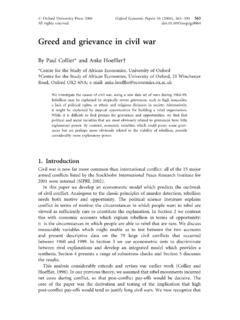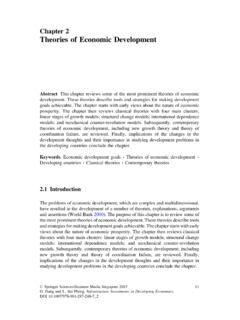Transcription of Notes for a Course in Development Economics
1 Notes for a Course in Development EconomicsDebrajRayVersion , 1 IntroductionOpen a book any book on the Economics of developing countries, and it will begin withthe usual litany of woes. Developing countries, notwithstanding the enormous strides theyhave made in the last few decades, display fundamental economic inadequacies in a widerange of indicators. Levels of physical capital per person are small. Nutrition levels are indicators of human capital such as education both at the primary and secondaylevels are well below developed-country benchmarks. So are access to sanitation, safewater and housing. Population growth rates are high, and so are infant mortality rates. Onecould expand this list that some of these indicators infant mortality or life expectancy, for instance may be regarded asdefiningfeatures of underdevelopment, so in this respect the list abovemay be viewed, not as a statement of correlations, but as a definition of what we mean bydevelopment (or the lack of it).
2 But other indicators, such as low quantities of physical capitalper capita, or population growth rates, are at least one step removed. These features don tdefineunderdevelopment. For instance, it is unclear whether low fertility rates areintrinsicallya feature of economic welfare or Development . Surely, many families in rich countries maytake great pleasure in having a large number of offspring. Likewise, large holdings ofphysical capital may well have aninstrumentalvalue to play in the Development process,but surely the mere existence of such holdings does not constitute a defining characteristicof economic indeed, that is how it should be. We do not make a list of the features that go hand inhand with underdevelopment simply to define the term. We do so because implictlyor explicitly we are looking for are underdeveloped countriesunderdeveloped?1It is easy enough to point to these inadequacies in terms of physicaland human capital, but the extra step to branding these ascausesof underdevelopment isperilously close, and we should avoid taking that step.
3 Low levels of capital, or low levelsof education, are just as much symptoms of Development as causes, and to the extent that1 Perhaps the word underdeveloped does not constitute politically correct usuage, so that several publications those by well-known international organizations chief among them use the somewhat more hopeful andplacatory present continuous developing . I won t be using such niceties in this article, because it should beclear or at least it is clear in my mind thateconomicunderdevelopment pins no derogatory social label onthose who live in, or come from, such intertwine with and accompany the Development process (or the lack of it), we cannotrely on these observations as doesn t stop economists from offering such explanations, however. More than oneinfluential study has regressed growth rates (alternatively, levels) of per-capita income onvariables such as the rate of savings and population growth.
4 There is very little doubt, in fact,that such variables are significantly associated with per-capita income. But nevertheless,we do have to think about the sense in which these studies serve instance, is it the case that individuals in different parts of the world have someintrinsicdifference in their willingness or ability to save, or to procreate? If this were the case,we could hang our hat on the following sort of theory: such-and-such country is populatedby people who habitually save very little. This is why they are , this does not seem right. We would like to have a theory which while notbelittling or downplaying the role of social, cultural and political factors does not simplystop there. We would like to know, for instance, whether low incomes provoke, in turn,low savings rates so that we have a genuine chicken-and-egg problem. The same is true ofdemographics underdevelopment might be a cause of high population growth rates, justas high population growth rates themselves retard the Development goal in these Notes is to talk about some of these chicken-and-egg situations, in whichunderdevelopment is seen not as a failure of some fundamental economic parameters,or socio-cultural values, but as an interacting equilibrium that hangs together, perhapsprecipitated by inertia or by history.
5 [Indeed, in what follows, I will make a conceptualdistinction between equilibria created by inertia and those created by history.]Why is this view of the Development process an important one? There are three reasonswhy I feel this view should be examined very seriously.[1] This point of view leads to a theory, or a set of theories, in which economic convergence (of incomes, wealth, levels of well-being) across countries is not to be automatically , the intelligent layperson reading these words will find this reasoning a bit abstruse:why on earth would one expect convergence in the first place? And why, indeed, should Ifind a theory interesting on the grounds that it doesnotpredict convergence, when I knewthat all along? This is not a bad line of reasoning, but to appreciate why it is misguided, it isimportant to refer to a venerable tradition in Economics that has convergence as its very coreprediction. The idea is based roughly on the argument that countries which are poorwill have higher marginal products of capital, and consequently a higher rate of return tocapital.
6 This means that a dollar of extra savings will have a higher payoffin poor countries,allowing it grow faster. The prediction: pooere countries will tend to grow faster, so thatover time rich and poor countries will come together, or converge .This is not the place to examine the convergence hypothesis in detail, as my intention isto cover other views of one should notice that convergence theoriesin this raw form have rarely been found acceptable (though rarely does not mean never,2 See Ray [1998], Chapters 2 and some economists), and there are several subtle variants of the theory. Some ofthese variants still preserve the idea that lots of other things being equal, convergencein some conditional sense is still to be had. It s only if we start accepting the possibilitythat perhaps these other things cannotbe kept equal, that the notion of conditionalconvergence starts losing its relevance and very different views of Development , not at allbased on the idea of convergence, must be sought.
7 [2] The second reason why I find these theories important is that they do not reply on fundamental differences across peoples or cultures. Thus we may worry about whetherConfucianism is better than the Protestant ethic in promoting hard-headed, succesfuleconomic agents, and we might certainly decry Hindu fatalism as deeply inimical topurposeful, economic self-advancement, but we have seen again and again that when itcomes down to the economic crunch and circumstances are right, both Confucian andHindu will make the best of available opportunities and so will the Catholics and a hostof other relgions and cultures besides. Once again, this is not the place to examine in detailfundamentalist explanations based on cultural or religious differences, but I simply don tfind them very convincing. This is not to say that culture like conditional convergence does not play a role. [In fact, I provide such examples below.]
8 ] But I also take the viewthat culture, along with several other economic , social and political institutions, are all partof some broader interactive theory in which first cause is to be found if at all inhistorical accident.[3] The last reason why I wish to focus on these theories is that create a very different role forgovernment policy. Specifically, I will argue that these theories place a much greater weighton one-time, or temporary, interventions than theories that are based on fundamentals. Forinstance, if it is truly Hindu fatalism that keeps Indian savings rates low, then a policy ofencouraging savings (say, through tax breaks) will certainly have an effect on growth there is no telling when that policy can be taken away, or indeed, if it can be taken awayat all. For in the absence of the policy, the theory would tell us that savings would revertto the old Hindu level. In contrast, a theory that is based on an interactive chicken-and-eggapproach would promote a policy that attempts to push the chicken-egg cycle into a newequilibrium.
9 Once that happens,the policy can be removed. This is not to say that once-and-for-all policies are the correct ones, but only to appreciate that the interactive theories I amgoing to talk about have very different implications from the traditional 2 The Calibration GameThe simple model of convergence also has to be put through enormous contortions to fit themost essential Development facts regarding per-capita income across countries. This is thepoint of the current Some Basic FactsLow per capita incomes are an important feature of economic underdevelopment perhapsthemost important feature and there is little doubt that the distribution of income acrossthe world s nations is extraordinarily Development Report(see, , World Bank [2003]) contains estimates for allcountries, converted to a common this yardstick, the world producedapproximately $32 trillion of output in 2001. A little less than $6 trillion of this lessthan 20% came from low- and middle-income developing countries (around 85% of theworld s population).
10 Switzerland, one of the world s richest countries, enjoyed a per capitaincome close to 400 times that of Ethiopia, one of the world s serious discrepancy arises from the fact thatpricesfor many goods in all countries are notappropriately reflected in exchange rates. This is only natural for goods and services that arenot internationally traded. The International Comparison Program publishes PPP estimatesof income, and under these the differences are still huge, but no longer of the order of 500 the period 1960 2000, the richest 5% of the world s nations averaged a per capitaincome (PPP) that was about twenty-nine times the corresponding figure for the poorest5%. As Parente and Prescott [2000] quite correctly observed, interstate disparitieswithintheUnited States do not even come close to these international figures. In 2000, the richest statein the United States was Connecticut and the poorest was Mississippi, and the ratio of percapita incomes worked out to slightly less than 2!








